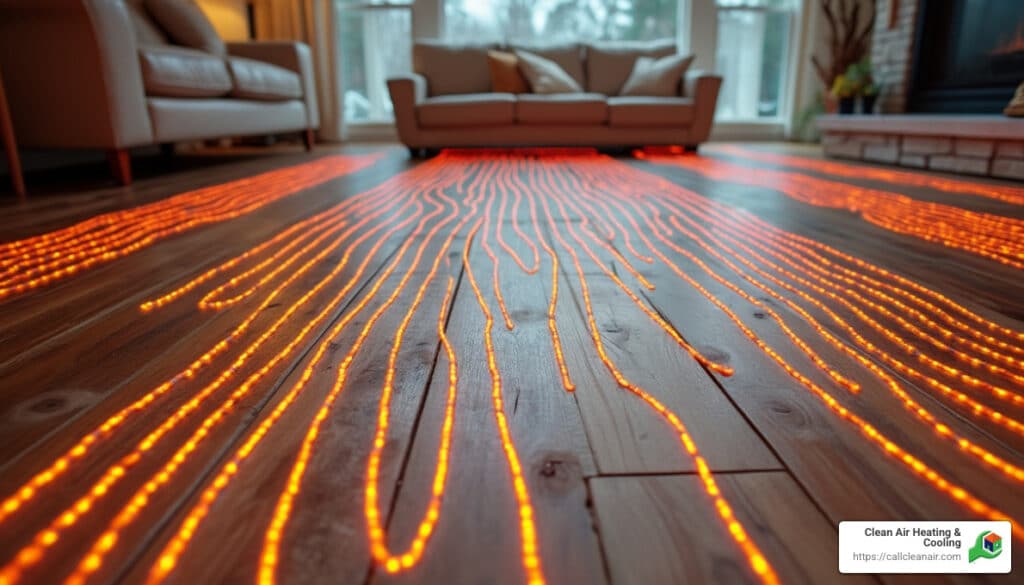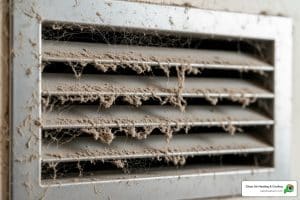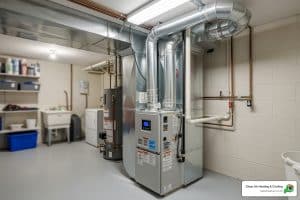Radiant floor heating reviews provide valuable insights into the comfort and efficiency this innovative system brings to homes, particularly in the chilly climates of Whatcom, Skagit, and Snohomish Counties. As you explore user experiences, here are some key points to consider:
- Even Heating: Radiant heat uniformly warms your home.
- Energy Efficiency: Known for reducing energy bills by up to 25%.
- User Comfort: Many users enjoy the luxury of warm floors.
- Silent Operation: No noisy heaters or rumbling ducts.
Radiant heating is appreciated not only for its energy-saving benefits but also for enhancing overall comfort by eliminating cold spots in rooms. Many homeowners rave about the warm floor experience during winter mornings.
As the owner of Clean Air Heating & Cooling, my commitment to enhancing home comfort aligns with the positive insights gained from radiant floor heating reviews. With a history of excellence in HVAC services, I’m here to guide you through making informed choices about your heating needs.

Learn more about radiant floor heating reviews:
– Energy efficient floor heating
– Heated floors installation cost
– Radiant floor heating maintenance
Pros and Cons of Radiant Floor Heating
Radiant floor heating offers a unique blend of comfort and efficiency, making it a popular choice for many homeowners. However, like any system, it comes with its own set of pros and cons. Let’s break them down.
Pros
Uniform Heating
One of the standout benefits of radiant floor heating is its ability to provide uniform heating. Unlike traditional forced-air systems that can create hot and cold spots, radiant heating warms the entire floor evenly. This results in a consistent ambient temperature throughout the room, enhancing comfort significantly.
No Maintenance
Once installed, radiant floor heating systems are virtually maintenance-free. Electric systems, in particular, can last over 20 years without any major issues. This reliability is a huge plus for homeowners looking for a “set it and forget it” solution.
Energy Efficient
Radiant floor heating is known for its energy efficiency. These systems can be 20-25% more efficient than traditional heating methods. By evenly distributing heat and reducing the need for ductwork, they minimize energy waste. Additionally, using programmable thermostats can further optimize energy usage and reduce heating costs.
Cons
Installation Cost
The initial installation cost of radiant floor heating can be higher compared to traditional systems. This is particularly true for electric systems installed under hardwood flooring. However, the long-term savings on energy bills often offset this initial investment over time.
Floor Height
Installing radiant floor heating can slightly increase the height of your floor, which might be a concern in some situations. This is usually more noticeable with hydronic systems that require additional layers for tubing. Planning is key to ensure this doesn’t disrupt door heights or transitions between rooms.
In conclusion, while radiant floor heating offers numerous benefits like even heating and energy efficiency, it’s important to weigh these against factors like installation cost and floor height adjustments. By considering these pros and cons, homeowners can make an informed decision that best fits their needs.
Types of Radiant Floor Heating Systems
When it comes to radiant floor heating, there are three main types to consider: electric systems, hydronic systems, and air heated floors. Each has its own benefits and ideal use cases, so let’s dive into what makes them unique.
Electric Systems
Electric radiant floor heating is a popular choice for many homeowners due to its versatility and ease of installation. These systems use electric cables or mats installed beneath the floor surface.
- Flexibility in Installation: Electric systems can be easily adapted for different room shapes and sizes. Whether you have a small bathroom or a large living room, electric mats and cables can be customized to fit your space perfectly.
- Ease of Use: Many electric systems come with programmable thermostats. This feature allows you to set the heating schedule according to your daily routine, ensuring warmth when you need it and saving energy when you don’t.
- Ideal for Renovations: If you’re planning a renovation, electric systems are easier to retrofit compared to hydronic systems. They don’t require major changes to your existing floor structure.
Hydronic Systems
Hydronic radiant floor heating, also known as hot water heating, is another effective option, especially for larger areas or whole-house heating.
- Efficient for Large Spaces: Hydronic systems use water heated by a boiler, which is then circulated through a network of tubes beneath the floor. This makes them highly efficient for heating larger spaces or entire homes.
- Long-Term Savings: Although the installation cost is higher, hydronic systems can be more cost-effective in the long run. The use of water as a heat transfer medium is generally more efficient than electricity in large-scale applications.
- Installation Considerations: These systems are best installed during new construction or major renovations due to the need for a boiler and extensive piping.
Air Heated Floors
Air heated floors are less common compared to electric and hydronic systems.
- How They Work: These systems circulate warm air through ducts beneath the floor. However, they are not as efficient as electric or hydronic systems because air doesn’t retain heat as effectively as water or electric cables.
- Limited Use Cases: Air heated floors are generally not recommended for residential use due to their lower efficiency. They are more often found in industrial settings where specific heating needs are required.
In summary, the choice between electric, hydronic, and air heated floors depends largely on your specific needs, budget, and the scale of the project. Electric systems offer flexibility and ease of installation, hydronic systems provide efficiency for larger areas, and air heated floors, while less common, serve niche applications. Understanding these options can help you select the best radiant floor heating system for your home.
Radiant Floor Heating Reviews
When it comes to radiant floor heating reviews, users often highlight a few key aspects: comfort, cost-effectiveness, and installation ease. Let’s explore what people are saying about these systems.
User Feedback
Many homeowners rave about the comfort that radiant floor heating brings to their daily lives. Imagine stepping onto a warm bathroom floor on a chilly morning—it’s a small luxury that makes a big difference. Users frequently mention that the even heat distribution eliminates cold spots in rooms, creating a cozy environment throughout.
One user shared, “The warmth feels like it’s hugging you from the ground up, and it’s so quiet you forget it’s even there.”
Comfort
Radiant floor heating is praised for providing consistent warmth. Unlike forced-air systems that can create drafts, radiant heating offers a uniform temperature. This makes spaces feel more comfortable at lower thermostat settings, which can be particularly beneficial in rooms with high ceilings or large open areas.
Cost-Effectiveness
While the initial installation cost can be higher than traditional heating systems, many users find radiant floor heating to be cost-effective in the long run. The energy efficiency of these systems can lead to noticeable savings on utility bills.
A homeowner from Bellingham, WA noted, “Our energy bills have decreased by about 25% since installing radiant floor heating. It’s been a fantastic investment.”
Installation Ease
Electric systems are often highlighted for their ease of installation, especially in existing homes or during renovations. They require minimal changes to the floor structure, making them a popular choice for DIY enthusiasts.
In contrast, hydronic systems are more complex and typically require professional installation. These systems are best suited for new builds or major renovations due to the need for a boiler and extensive piping.
Overall, radiant floor heating receives high marks from users for its comfort, efficiency, and the cozy atmosphere it creates in homes. Whether you’re considering it for a single room or an entire house, the feedback suggests it’s a worthwhile upgrade for those seeking improved comfort and energy savings.
Frequently Asked Questions about Radiant Floor Heating
What is the downside of radiant heat?
Radiant floor heating is generally praised for its comfort and efficiency, but it’s not without its downsides. One of the main issues is that it can be slow to heat. Unlike forced-air systems that can quickly blast warm air into a room, radiant heating takes time to warm up a space. This can be a disadvantage if you need quick heat on a cold day.
Another concern is its inefficiency in uninsulated spaces. Radiant floor heating works best in well-insulated areas. If your home has poor insulation, the heat might escape, making the system less effective and more costly to run.
Is radiant floor heating worth it?
Many homeowners find that radiant floor heating is worth the investment due to its energy efficiency. These systems are often more efficient than traditional heating methods because they distribute heat evenly and reduce heat loss through ducts.
In addition to energy savings, radiant floor heating offers allergy benefits. Since it doesn’t rely on moving air, it doesn’t circulate dust and allergens like forced-air systems do. This can be a significant advantage for people with allergies or asthma.

What is the life expectancy of radiant floor heating?
Radiant floor heating systems are built to last. The life expectancy of these systems typically ranges from 30 to 40 years, depending on the type and quality of the installation.
Maintenance is minimal, especially for electric systems, which have no moving parts and are less prone to wear and tear. Regular inspections can help ensure the system remains in good condition, but most users find that their radiant floor heating requires little attention over the years.
These factors make radiant floor heating a durable and low-maintenance option for those looking to improve their home’s comfort and efficiency.
Conclusion
At Clean Air Heating & Cooling, we take pride in offering top-notch radiant floor heating solutions that prioritize both comfort and efficiency. Our commitment to customer satisfaction is unwavering, as evidenced by our impressive track record of over 480 5-star Google reviews.
We understand that investing in a heating system is a significant decision. That’s why we offer a 25% utility savings guarantee to ensure you get the best value for your money. Our systems are designed not only to keep your home warm and cozy but also to help you save on energy costs in the long run.
Our team is dedicated to delivering prompt, high-quality service, ensuring that your radiant floor heating system is installed with precision and care. Whether you’re in Whatcom, Skagit, Snohomish, or San Juan Counties, we’re here to support your heating needs with our expertise and friendly service.
If you’re considering radiant floor heating for your home, we invite you to learn more about our services and find how Clean Air Heating & Cooling can improve your indoor comfort while reducing your energy bills.
Experience the warmth and efficiency of radiant floor heating with a company that puts your satisfaction first.






